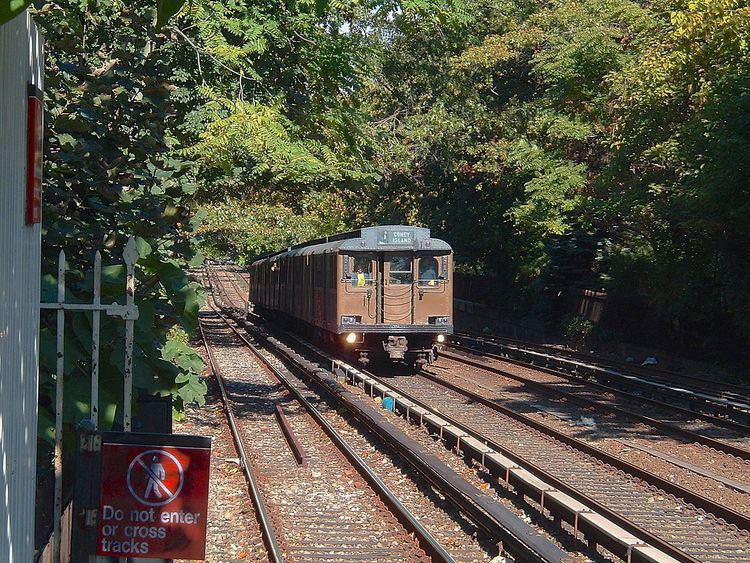In service 1925–1965 Number built 121 Number scrapped 118 | Constructed 1925, 1927–1928 Number preserved 3 | |
 | ||
Manufacturer | ||
The D-Type, commonly known as the Triplex, is a retired New York City Subway car with four units built as a prototype in 1925 and the production units built during 1927 and 1928.
History
The "D"s were purchased by the Brooklyn–Manhattan Transit Corporation specifically to augment the service provided by the BMT/BRT A/B Standards. They were used over the years in Southern Division lines based at Coney Island. This permitted several of the A/B units used in these services to be transferred to East New York, and in turn permitted the removal of the last BU wooden el cars from service in the BMT Nassau Street Line. Other service improvements included the extension of various lines — the BMT Fourth Avenue Line one station from 86th Street to Bay Ridge – 95th Street and the BMT Canarsie Line from Montrose Avenue to a connection at East New York with the other lines operating out of that point. In addition, most stations along the Southern Division lines were being extended to permit operation of maximum length trains – 8 car "A/B"s or 4 unit "D"s.
They were originally placed in service on the Fourth Avenue Local running from 95th Street to Queensboro Plaza, with some additional units used on the Brighton Local. This was undoubtedly done to provide maximum exposure for these cars; however, in September 1928, before the entire fleet of 121 units had been delivered, the units serving in Fourth Avenue Local service were transferred to the Sea Beach Express, where, as heavyweight cars with a slow acceleration but very fast overall speed, it was felt that they could provide better service. In 1932, full length trains of these units began operating with only one conductor aside from the motorman.
The first major change of assignment for these cars came on April 27, 1950, when the units on the Brighton Local were transferred to Brighton Express service. The BMT Astoria Line's platforms were still under construction, and parts of the platforms were still closed to passengers, requiring trains to use two conductors when travelling on that line. As the A/B trains still used two conductors until September 1958, this move served to save on crews, although "D"s continued to be used on certain fixed intervals on the Brighton Local until December 1, 1955, and sporadically after that date.
On May 27–28, 1959, the Brighton Express now became virtually all D-Type (except once again for certain fixed intervals which used A/B's), with the Sea Beach Express for the first time in nearly 31 years seeing the usage of A/B-Types along with the D-Types that were still used. With the drastic reduction in West End service that took place at this time, it was decided to run all Sea Beach trains at maximum length 8 cars. The Brighton Express, in the meantime, continued to run a fluctuating 6 or 8 car service during the course of the day, which required much coupling and cutting of trains. As the D-Types were better suited for this purpose, having a much more advanced type of coupler, it was decided to keep these cars for that purpose on the Brighton Express, where they served virtually until the end of their lives.
A further change came over the days April 13–15, 1963, when the units used on the Sea Beach Express were transferred to the West End Express as well as the various Nassau Street services as needed. As these cars were approaching their last days, and were now seen as oddball types, it was decided to cut their mileage as much as possible to simplify maintenance procedures; moveover, by June of that year, they began to reappear on the Sea Beach Express once again along with the above. This was undoubtedly to dissipate the mileage on them even further. The oft stated concern of their being too heavy for the Manhattan Bridge was apparently not a factor, as they could be seen in service on the Bridge to the very end of their lives.
Over their entire lifetime, they had appeared in all Southern Division services at one time or other, including all Nassau Street services, weekend Franklin Avenue Local service to Brighton Beach, Culver Shuttle, and also to Astoria and via the 60th Street Tunnel Connection and over the IND Queens Boulevard Line to Forest Hills (during the 1957 motorman's strike, some units ran over this line to 179th Street).
The units had a reputation with the BMT and subsequent operating agencies for being especially reliable, requiring minimal maintaining and experiencing fewer breakdowns than other New York subway equipment. The last units were retired from service on July 23, 1965, the last train in service having operated as a West End Local in the A.M. rush on that date.
